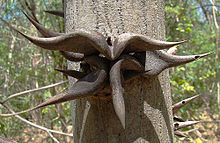Ball-headed acacia
| Ball-headed acacia | ||||||||||||
|---|---|---|---|---|---|---|---|---|---|---|---|---|

Ball-headed acacia ( Acacia collinsii ) |
||||||||||||
| Systematics | ||||||||||||
|
||||||||||||
| Scientific name | ||||||||||||
| Acacia collinsii | ||||||||||||
| ( Saff. ) Seigler & Ebinger |
The spherical acacia ( Vachellia collinsii ) is a species of the genus ( Vachellia ) within the legume family (Fabaceae). It comes from the dry forests of southern Central America and it is one of the species from the Acacieae tribe in whose hollow thorns various species of ants , such as Pseudomyrmex spinicola and Pseudomyrmex ferruginea ( Myrmekophylaxis ) live .
description
The spherical acacia grows as a small tree and reaches heights of up to 10 meters. The dark gray to brown bark is slightly furrowed. The bark of the branches is smooth and reddish-brown to dark brown. The alternate leaves arranged on the branches are divided into petioles and leaf blades and are 4 to 16 centimeters long. The 4 to 18 millimeter long petioles have two to five broad dome-shaped glands at their base . The double-pinnate leaf blade consists of 3 to 15 pairs of pinnate first order. Each first-order leaflet contains 11 to 29 pairs of leaflets . The stipule spines are light reddish brown to dark brown and round in cross section.
The flowering period extends from January to August. The flowers are in cylindrical, spiked inflorescences , which are surrounded by four bracts . The seated flowers are yellowish with five 1 to 1.4 millimeter long sepals and five, only slightly longer petals . The dark brown to black legume is 3 to 6 inches long and straight. The seeds are dark brown, egg-shaped and have a yellowish aril .
symbiosis
The stipple thorns of the spherical acacia are hollow and serve as a residential area for the ants who only have to expose an entrance just below the tip. The aggressive ants protect the tree from feeding damage by insects by driving away any insects that settle on it. They also keep the competing vegetation surrounding the acacia short. In exchange, the tree produces nectar through the glands on the leaf stalks and at the ends of the leaflets protein- and fat-rich food (Belt's body) to feed the ants.
An ant colony can colonize several acacias. Acacias, which are not yet home to an ant colony, have to produce food poisons in order to ward off herbivorous insects. Young acacia plants without an ant colony grow more slowly and are quickly overgrown by other plants.
distribution
The ball-headed acacia has the widest distribution of all "ant acacias" next to Vachellia cornigera and is the most adaptable. Vachellia collinsii occurs in Mexico in Yucatán and in central Chiapas , in Guatemala in the northern province of El Peten , in the eastern half of Honduras and on its short coast on the Pacific, in Nicaragua , in northwestern Costa Rica , in the province of Guanacaste with the Nicoya - Peninsula and on the Pacific side of western Panama with the Azuero Peninsula in front.
Taxonomy
The first description was under the name ( Basionym ) Acacia collinsii Saff. The new combination to Vachellia collinsii (Safford) Seigler & Ebinger was published in 2005 by David S. Seigler and John E. Ebinger in New combinations in the genus Vachellia (Fabaceae: Mimosoideae) from the New World in Phytologia , Volume 87, p. 150. Other synonyms are Myrmecodendron collinsii (Saff.) Britton & Rose , Acacia nelsonii Saff. , Acacia penonomensis Saff. , Acacia glutea Ram. , Acacia costaricensis Schenck , Acacia panamensis Schenck , Acacia yucatanensis Schenck .
swell
- DH Janzen: Swollen-Thorn Acacias of Central America . In: Smithsonian Contributions to Botany . tape 13 , 1974 ( pdf ).
- Vachellia collinsii in J. Miller: Acacia Systematics and Ecological Genomics .
